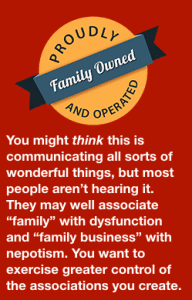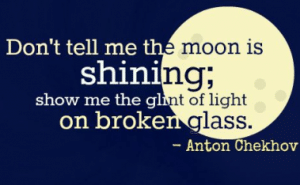 “Kill all clichés and ad speak” — standard, Ad Writing 101 advice.
“Kill all clichés and ad speak” — standard, Ad Writing 101 advice.
Good advice — certainly not wrong. It’s just not very helpful.
Always better to let the good drive out the bad, than to remove the bad and wonder with what to replace it.
For example, some ad clichés that typically get put in the cross hairs include:
- Family Owned
- Locally Owned
- In Business Since 19XX
- Fast, Friendly Service
- For All Your _____ Needs
- Competitively Priced
- We / They (Really) Care
But the first thing to do is NOT to just cross these phrases out, and then wonder what to say instead.
The first thing to do is to realize that these phrases aren’t effectively communicating what you think or hope they’re communicating (assuming that you’re saying these things for a reason and not merely as filler)
What “Family Owned” Is Really Trying to Say
 Take “Family Owned.” Being family owned can be a fantastic thing, with some genuine benefits to the customer and the community.
Take “Family Owned.” Being family owned can be a fantastic thing, with some genuine benefits to the customer and the community.
But merely saying “family owned” in your ad doesn’t help anyone to understand those benefits.
So for every cliché you’ve got in an ad, ask yourself:
- What is it that I’m really trying to say?
- Why do I think this should matter to a customer?
So, for “Family Owned” it might go something like this:
- There’s an actual owner who takes a “the buck stops here” approach to running the business — someone you can talk to if anything goes wrong or you need to address a warranty issue, or you’re just not happy.
- That owner has put his or her “name” on the business, meaning that their reputation is on the line and they’ll stand behind their work.
- There is (possibly) multi-generational experience and expertise involved — we/they really know what we’re/they’re doing.
- The business is likely to have a personality — the personality of the family or owner — rather than being a bland Big Box corporate beige experience.
- This is as much a passion for the owners as a job.
- And so on.
Now take each of those bullet points and figure out how you can make that point as succinctly and memorably as possible.
At this point you now have something to replace the cliche.
Something so much better than what you started with.
But still not anywhere near great.
Show, Don’t Tell & Dramatize, Don’t Proselytize
 If you want to get to great, you have to do either one of two things:
If you want to get to great, you have to do either one of two things:
- Figure out how to dramatize each point so that the audience will feel and believe it, rather than just be told it.
- Figure out how to dramatize ALL of the points within a thematically consistent campaign.
If you’d like to see what that might look like — what “great” looks like — I invite you to check out my article on Columbia Sportswear’s One Tough Mother campaign.
That campaign is basically “Family Owned” done right.
And if you’d like help figuring out how to dramatize the things you’re really trying to communicate to customers, I’d be happy to help.
P.S. Sometimes you’ll find that a cliché is not only ineffective in how it communicates, but misguided in what it’s communicating.
For example, claiming superior (or “fast and friendly”) customer service is usually a mistake unless you very carefully manage expectations about what superior service entails. In this case, it’s likely better to abandon this messaging point altogether rather than salvaging or improving it.
- Are You Paying for Too Much for the Wrong Keywords? - July 15, 2024
- Dominate Your Market Like Rolex — 4 Powerful Branding Lessons - July 3, 2024
- Military-Grade Persuasion for Your Branding - June 25, 2024
